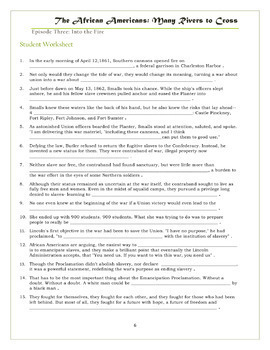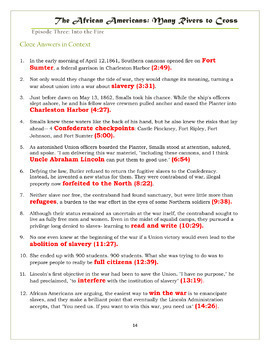The African Americans Many Rivers to Cross Worksheets for ENTIRE SERIES Bundle
- Zip
- Easel Activity
What educators are saying
Products in this Bundle (6)
showing 1-5 of 6 products
Description
Six sets of fill-in worksheets, one for each episode. All questions have optional time stamps; all worksheets come with an optional student answer sheet to streamline grading and allow multiple uses of your printouts. Full context and fast-grade answer keys included!
The African Americans: Many Rivers to Cross, is an award-winning six-part documentary series by noted historian Henry Louis Gates, Jr. Covering from about the year 1500 through to the new millennium, the series addresses in a detailed yet entertaining way the challenges faced by African Americans throughout these centuries as well as their many triumphs. Each episode lasts approximately one hour, making the series a convenient one to work into a typical high-school class period.
About these African Americans: Many Rivers to Cross Worksheets
This worksheet packet includes six worksheet sets, one for each episode of the acclaimed series\ The African Americans: Many Rivers to Cross. Together, these six worksheets provide students with hundreds of fill-in-the-blank problems for them to solve as they watch their way through the series. These African Americans Many Rivers to Cross Worksheets for the entire series covers the period of 1500 to 2013 in American history, focusing in on the African American experience throughout that time.
Teaching Possibilities for these The African Americans Worksheets
Because the series spans such a long era, teachers may want to use it sporadically throughout the school year to review and reinforce student learning about specific time periods. This approach will allow students to see each era through the lens of a different viewpoint immediately after going through the textbook presentation of that era. Compare/contrast activities can naturally follow, and can help students see how in many cases, their textbooks are presenting an incomplete or even biased view of history. It can also help students see how history can *look* different to those actually experiencing the events. Textbooks, by their nature, tend to be impersonal, while the series presents students with anecdotes and stories that show the impact of events on actual lives.
Another option is to reserve the series for near the end of the school year so that it can be used as a review of all of American history – again showing events from an extra-textbook viewpoint.
How These African Americans: Many Rivers to Cross Worksheets are Structured
These The African Americans: Many Rivers to Cross worksheets present students with fill-in problems to encourage them to pay close attention to the video as it plays. Cloze problems largely eliminate the problem of students guessing, and when they are well-constructed, they have the added benefit of helping students to zero in on main ideas and key details – exactly the content they should be mastering from the video.
Each hour-long episode comes with between 40 and 70 fill-in problems, appropriately spaced out so that students can keep up. Some students, however, may feel that the pace is too brisk. In that case, teachers can simply assign some students to do the odd problems and others the evens, a strategy that can also help to discourage students from copying from classmates instead of paying attention as they should.
Teacher Convenience Features in these African Americans Episode 6 Worksheets
Some teachers like providing their students with time stamps to go with video questions, so they know when to expect the next problem. Other teachers would rather instruct students to listen carefully for the following cue sentence so they are ready to tackle the next problem.
These worksheets for The African Americans accommodate both teaching styles, including both a worksheet with a time stamp for each problem and a matching worksheet that leaves the time stamps out.
Looking for an Easy Grading Option? Here you go!
Each worksheet provides students with blanks that they can write on. While this may be the best option for some students, teachers can considering using the included student answer sheet instead. With this approach, all a student’s answers will be on a single sheet of paper, one that is formatted to exactly match the “Fast-Grade Answer Key” so that student papers can be rapidly and easily marked.
Using the student answer sheet and Fast-Grade Answer Key offers an additional benefit too – teachers can make one class set of worksheets and re-use them period after period and year after year to cut down on the time and expense of making copies! Just give students an answer sheet, remind them not to write on the worksheets themselves, and you’re good to go!
Looking to Go Over Answers with the Class?
In that case, the “Cloze Answers in Context” answer key should prove helpful because it provides teachers with the question prompts as well as the answers. This will allow teachers to read the prompt out loud and let the class or specified students announce the answer. Teachers can even designate a student leader to read the prompts and verify the answer once it’s given, providing students with the opportunity to augment their learning even further!
However you choose use these The African Americans: Many Rivers to Cross worksheets, I hope that you find the video series and entertaining and informative addition to your American history teaching materials.
FOR YOUR REFERENCE: Episode Summaries from PBS
Episode One: The Black Atlantic (1500 – 1800)
The Black Atlantic explores the truly global experiences that created the African-American people. Beginning a full century before the first documented “20-and-odd” slaves who arrived at Jamestown, Virginia, the episode portrays the earliest Africans, both slave and free, who arrived on these shores. But the transatlantic slave trade would soon become a vast empire connecting three continents. Through stories of individuals caught in its web, like a 10-year-old girl named Priscilla who was transported from Sierra Leone to South Carolina in the mid-18th century, we trace the emergence of plantation slavery in the American South. The late 18th century saw a global explosion of freedom movements, and The Black Atlantic examines what that Era of Revolutions — American, French and Haitian — would mean for African Americans and for slavery in America.
Episode Two: The Age of Slavery (1800 – 1860)
The Age of Slavery illustrates how black lives changed dramatically in the aftermath of the American Revolution. For free black people in places like Philadelphia, these years were a time of tremendous opportunity. But for most African Americans, this era represented a new nadir. King Cotton fueled the rapid expansion of slavery into new territories, and a Second Middle Passage forcibly relocated African Americans from the Upper South into the Deep South. Yet as slavery intensified, so did resistance. From individual acts to mass rebellions, African Americans demonstrated their determination to undermine and ultimately eradicate slavery in every state in the nation. Courageous individuals, such as Harriet Tubman, Richard Allen and Frederick Douglass, played a crucial role in forcing the issue of slavery to the forefront of national politics, helping to create the momentum that would eventually bring the country to war.
Episode Three: Into the Fire (1861 – 1896)
Into the Fire examines the most tumultuous and consequential period in African-American history: the Civil War and the end of slavery, and Reconstruction’s thrilling but tragically brief “moment in the sun.” From the beginning, African Americans were agents of their own liberation — forcing the Union to confront the issue of slavery by fleeing the plantations, and taking up arms to serve with honor in the United States Colored Troops. After Emancipation, African Americans sought to realize the promise of freedom — rebuilding families shattered by slavery; demanding economic, political and civil rights; even winning elected office. Just a few years later, however, an intransigent South mounted a swift and vicious campaign of terror to restore white supremacy and roll back African-American rights. Yet the achievements of Reconstruction would remain very much alive in the collective memory of the African-American community.
Episode Four: Making a Way Out of No Way (1897 – 1940)
Making a Way Out of No Way portrays the Jim Crow era, when African Americans struggled to build their own worlds within the harsh, narrow confines of segregation. At the turn of the 20th century, a steady stream of African Americans left the South, fleeing the threat of racial violence, and searching for better opportunities in the North and the West. Leaders like Ida B. Wells, W.E.B. Du Bois, Booker T. Washington and Marcus Garvey organized, offering vastly different strategies to further black empowerment and equality. Yet successful black institutions and individuals were always at risk. At the same time, the ascendance of black arts and culture showed that a community with a strong identity and sense of pride was taking hold in spite of Jim Crow. “The Harlem Renaissance” would not only redefine how America saw African Americans, but how African Americans saw themselves.
Episode Five: Rise! (1940 – 1968)
Rise! examines the long road to civil rights, when the deep contradictions in American society finally became unsustainable. Beginning in World War II, African Americans who helped fight fascism abroad came home to face the same old racial violence. But this time, mass media — from print to radio and TV — broadcast that injustice to the world, planting seeds of resistance. And the success of black entrepreneurs and entertainers fueled African-American hopes and dreams. In December 1955, Rosa Parks refused to give up her seat to a white man on a city bus in Montgomery, Alabama, heralding the dawn of a new movement of quiet resistance, with the Reverend Dr. Martin Luther King, Jr. as its public face. Before long, masses of African Americans practiced this nonviolent approach at great personal risk to integrate public schools, lunch counters and more. As the civil rights movement scored one historic victory after another, non-violence was still all too often met with violence — until finally, enough was enough. By 1968, Dr. King, the apostle of non-violence, would be assassinated, unleashing a new call for “Black Power” across the country.
Episode Six: A More Perfect Union (1968 – 2013)
After 1968, African Americans set out to build a bright new future on the foundation of the civil rights movement’s victories, but a growing class disparity threatened to split the black community in two. As hundreds of African Americans won political office across the country and the black middle class made unprecedented progress, larger economic and political forces isolated the black urban poor in the inner cities, vulnerable to new social ills and an epidemic of incarceration. Yet African Americans of all backgrounds came together to support Illinois’ Senator Barack Obama in his historic campaign for the presidency of the United States. When he won in 2008, many hoped that America had finally transcended race and racism. By the time of his second victory, it was clear that many issues, including true racial equality, remain to be resolved. Now we ask: How will African Americans help redefine the United States in the years to come?
LOOKING FOR INDIVIDUAL EPISODES OF THE AFRICAN AMERICANS WORKSHEETS? HERE ARE LINKS TO THE COMPLETE COLLECTION:
The African Americans Episode 1 Worksheet: The Black Atlantic -- 1500 – 1800
The African Americans Episode 2 Worksheet: The Age of Slavery 1800 – 1860
The African Americans Episode 3 Worksheet: Into the Fire -- 1861 – 1896
The African Americans Episode 4 Worksheet: Making a Way Out of No Way -- 1896 – 1940
The African Americans Episode 5 Worksheet: Rise! -- 1940 – 1968
The African Americans Episode 6 Worksheet: A More Perfect Union -- 1968 – 2013
As always, happy teaching,
Elise Parker




